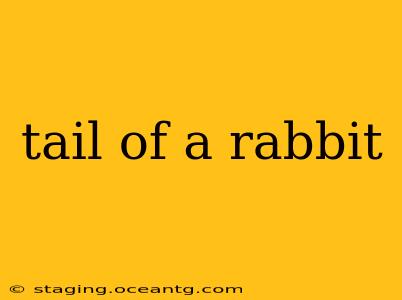Rabbits, with their endearingly long ears and twitching noses, are beloved creatures. But have you ever stopped to consider their tails? More than just a fluffy appendage, a rabbit's tail plays a crucial role in its survival and communication. This comprehensive guide will delve into the fascinating world of the rabbit's tail, exploring its various functions and answering some frequently asked questions.
What is the purpose of a rabbit's tail?
A rabbit's tail serves multiple important purposes:
-
Communication: The tail is a key component of rabbit body language. A raised tail often indicates alertness and a relaxed, happy state. A lowered tail, conversely, might signal fear or submission. A rapidly thumping tail on the ground is a warning signal to other rabbits of potential danger. This thumping serves as a clear, audible alert, even when the rabbit itself may be hidden from view.
-
Balance: While not as crucial as for some other animals, the tail does aid in balance, particularly during quick turns and jumps. Its relatively short length means it's not a primary balancing tool, but it still provides a subtle degree of assistance.
-
Thermoregulation: While less significant than other thermoregulatory mechanisms like ears and fur, the tail can play a small part in heat dissipation. The blood vessels within the tail help to regulate body temperature to a minor extent.
-
Protection: Although not a defensive weapon in the same way as a squirrel's bushy tail, a rabbit's tail provides a small measure of protection during quick escapes from predators. It can help to steer the rabbit away from danger.
What are the different types of rabbit tails?
While there isn't a formal classification of rabbit tails into distinct "types," the length and fur density can vary depending on the breed. Some breeds have longer, fluffier tails, while others have shorter, more compact ones. These variations don't generally impact the functional roles of the tail.
Why does my rabbit thump its tail?
As mentioned earlier, tail thumping is a crucial communication signal. It's often a warning sign, alerting other rabbits (and sometimes even humans!) to potential threats, such as a predator, a sudden loud noise, or even an unsettling change in the environment. It's a way for rabbits to communicate warnings without making themselves vulnerable by vocalizing.
How long is a rabbit's tail?
The length of a rabbit's tail varies significantly between breeds. Some breeds, such as the Flemish Giant, may have longer tails, whereas smaller breeds may possess shorter tails. Generally, a rabbit's tail length is a relatively small proportion of its overall body length.
Can a rabbit's tail be injured?
Yes, a rabbit's tail, like any other part of its body, can be injured. Tail injuries are, however, not particularly common in domesticated rabbits. If you notice any signs of injury to your rabbit's tail, such as bleeding, swelling, or unusual behavior, you should consult a veterinarian immediately.
What does it mean when a rabbit holds its tail high?
A rabbit holding its tail high is often a sign of confidence and contentment. It indicates that the rabbit feels relaxed, secure, and comfortable in its surroundings. This posture contrasts sharply with a lowered tail, which might suggest fear or apprehension.
This exploration into the fascinating world of the rabbit's tail reveals its significance in communication, balance, and even a minor role in thermoregulation. Understanding these aspects of rabbit behavior enriches our appreciation of these captivating creatures and enables us to better care for them. Remember to always consult a veterinarian if you have any concerns about your rabbit's health.
